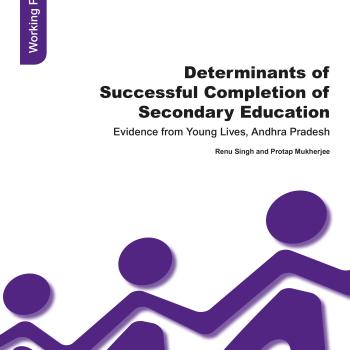
As India comes close to realising universal enrolment at primary and upper primary levels, the universalisation of secondary education has become critical if the country is to achieve equitable social development and build a skilled workforce. The Rashtriya Madhyamik Rashtriya Shiksha Abhiyan (the National Mission for Secondary Education) was launched to increase access and improve quality, but in 2013/14 only 46 per cent of children were enrolled in secondary school. This mixed-methods paper uses Young Lives longitudinal data to explore factors affecting completion of secondary education.
We find that a multitude of factors across the household, individual, educational and social demographic domains affect children’s secondary school completion.
Girls remain disadvantaged and are 45 per cent less likely to complete secondary education than boys. Children with good reading skills at the age of 8 were found to be 1.7 times more likely and children with good writing skills were 3.3 times more likely to complete secondary education than children who had relatively poor reading or writing skills at age 8. Children with a higher self-efficacy index are found to be nearly 1.7 times more likely to successfully progress through secondary education than children with low self-efficacy. Children who spent three or more hours per day doing domestic chores at age 12 were 70 per cent less likely to complete secondary education, while those who did paid work at age 12 were 54 per cent less likely to get a secondary school certificate.
The fact that boys are almost twice as likely as girls to complete secondary education requires urgent policy attention, particularly in rural areas. Much more attention needs to be given to pre-school education and literacy skills in the early primary years, since there is a strong co-relation with the completion of secondary education. It is also important that children in primary school are not drawn into paid work, since this has a detrimental effect on their long-term schooling – and lowers the chances that they will complete secondary education.

As India comes close to realising universal enrolment at primary and upper primary levels, the universalisation of secondary education has become critical if the country is to achieve equitable social development and build a skilled workforce. The Rashtriya Madhyamik Rashtriya Shiksha Abhiyan (the National Mission for Secondary Education) was launched to increase access and improve quality, but in 2013/14 only 46 per cent of children were enrolled in secondary school. This mixed-methods paper uses Young Lives longitudinal data to explore factors affecting completion of secondary education.
We find that a multitude of factors across the household, individual, educational and social demographic domains affect children’s secondary school completion.
Girls remain disadvantaged and are 45 per cent less likely to complete secondary education than boys. Children with good reading skills at the age of 8 were found to be 1.7 times more likely and children with good writing skills were 3.3 times more likely to complete secondary education than children who had relatively poor reading or writing skills at age 8. Children with a higher self-efficacy index are found to be nearly 1.7 times more likely to successfully progress through secondary education than children with low self-efficacy. Children who spent three or more hours per day doing domestic chores at age 12 were 70 per cent less likely to complete secondary education, while those who did paid work at age 12 were 54 per cent less likely to get a secondary school certificate.
The fact that boys are almost twice as likely as girls to complete secondary education requires urgent policy attention, particularly in rural areas. Much more attention needs to be given to pre-school education and literacy skills in the early primary years, since there is a strong co-relation with the completion of secondary education. It is also important that children in primary school are not drawn into paid work, since this has a detrimental effect on their long-term schooling – and lowers the chances that they will complete secondary education.

